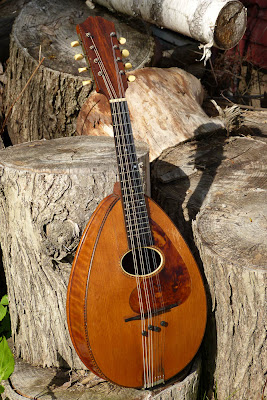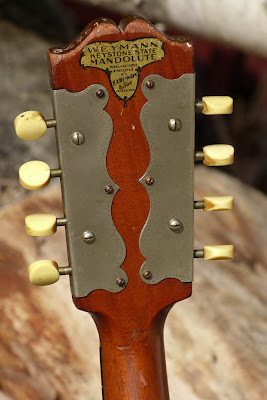c.1923 Weymann Style 30 Mandolute Mandolin
I worked on this same instrument for a customer last year but this year I took it in trade towards a different instrument. Work then included a fret level and dressing as well as a couple hairline crack fills on the back, cleating of a top hairline crack near the soundhole, and shoring up of some seams. The neck had slight relief overall and while it played decently it wasn't spot on. Getting it back this time, I pulled all the old frets out, planed the neck, and installed a new set of frets. This got the setup and action perfect and it plays and feels as if it were a brand new instrument.
The "Mandolute" moniker used by Weymann always confuses people who aren't up on them. It's just a branding for their mandolin line of this type, vs. a proper instrument type (like mandolin). This means that their Mandolute instruments generally share the same specifications: a "domed" spruce top and back, which are press-arched, flamed maple back and sides (the lower end models have mahogany), and "violin" edging on the sides which give them a distinctive, upper-class look.
Note the hairline going up from the soundhole. Many old Weymanns have this from being over-strung and left to sit over time. It's a compression hairline. I cleated it in 2012.
Also note how light in color the finish is on the back and sides and how mellow-yellow-orange the top has become. This instrument has obviously seen a lot of sunlight in its day. Originally those back and sides would have been a rosier red color and the inlaid purfling around the soundhole would have been popping with a bit of color.
This ebony bridge is unoriginal, as I recall, and from my parts bin. The overtone mutes are rubber grommets from the hardware store and cut down on odd ring when playing melody.
Nice rosewood headstock veneer. Original bone nut.
The board is ebony. As you can see, there was some chipout when replacing the frets and planing the board. This might not have happened but particularly with many 20s instruments, where the board has been "ebonized" with dye to insure a uniform look, the top layer of the board will be more brittle and it can be frustrating to do fret work.
In the end, it dressed up nicely and this thing feels great to play. It has the "Gibson" 13 7/8" scale, though due to the light construction, I only okay these for 32w-09 string sets (extra light) such as the GHS A240 set.
Check out that beautiful maple!
These really are super-pretty instruments.
There are a couple drop-filled, tight hairline cracks on the back, but they're stable and no worry.
The enclosed tuners look and work great. The headstock itself has a small break right under the nut that (as I recall) I repaired last year as well.
Here's the label, serial number, and style number.
Good, sturdy neck joint.
The original tailpiece is missing it's cover (what's new?) but it does have this cute 70s strap button added.
















Comments